Homeworld 2 Q&A
We speak with Relic's Dan Irish and Josh Mosqueira to get new details on the next game in the Homeworld saga.
Homeworld, Relic Entertainment's first game, was as distinct in concept as it was visually impressive. When it was released in 1999, it was the first game to ever depict tactical space battles in full 3D, and engagements in the game would often involve dozens if not hundreds of units at once, with everything from interceptor fighters and multiple-turret corvettes to ion-beam frigates and capital ships. And there was a memorable single-player story to back it all up.
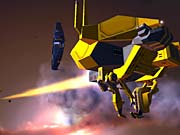
Little has been seen or heard of Homeworld 2, but the sequel has been in development for quite some time and is expected to be completed late this year. Relic is now taking the wraps off and is ready to talk about the game, particularly since the studio's most recent game, Impossible Creatures, shipped in January. We recently spoke with Dan Irish, executive producer for Homeworld 2, and Josh Mosqueira, the game's lead designer, to get plenty of new details on what the sequel will offer, including a sinister new enemy, many new units and gameplay refinements, and a bounty of new visual effects.
GameSpot: Give us an overview of Homeworld 2's story. Do things pick up directly after the first game or take into account the events of Homeworld: Cataclysm? Are there any elements of the new game's setting that will be familiar?
Dan Irish: Homeworld 2 continues the epic struggle of the hiigarans and their leader, Karan S'jet. The "exiles" thought their hardships would end when they returned to Hiigara, but fate would not be so kind to them. From the Inner Rim, the hiigarans face a new and bitter enemy. Homeworld 2 focuses on another voyage of the mothership and its crew. This journey takes the hiigarans from their homeworld into oldest regions of the galaxy to confront their new foe and learn the truth behind their exile.
In Homeworld, the exiles reclaimed their home. In Homeworld 2, they reclaim their destiny.
GS: Since Homeworld's release in 1999, Relic has been pretty busy with Impossible Creatures. That was a different sort of game, but has the experience benefited Homeworld 2 in any way?
DI: Homeworld 2 benefits in a number of ways from Impossible Creatures. The most visible benefits are in the special effects, explosions, and damage effects. The tool that we developed for these purposes in Impossible Creatures was converted for our use in Homeworld 2. The artist who created the special effects, Nick Carota, also joined the team, bringing his vast experience with using the tool. The other visible way that we've benefited is in the growth around launching another title. Every time an original concept is created into a game, we refine the creative process so it is easier to prototype ideas and get art assets to a stage where we can see if the concept has merit. You'll see that in the polish and improvement in Homeworld 2.
GS: Tell us about the playable sides. How many factions will be in the game? Are there plans to make the factions in Homeworld 2 more unique than the kushan and taidan units were in Homeworld?

DI: Homeworld 2 features two unique fleets of ships. There are some similarities between the Homeworld fleet of the kushan and the hiigarans of Homeworld 2. While some ships are obvious descendants from those in Homeworld, most are new and have never been seen before. Of course, the design of the mothership has survived for this long, so as you can see in the screenshots, it remains the mainstay of the fleet.
As for the vaygr, the antagonists, they have very distinctive ships that draw few parallels to anything that's been seen before in Homeworld. There are some functional similarities in certain units, but we're hoping to surprise the core fans with the sinister design of this fleet.
Josh Mosqueira: These differences are not only skin-deep. Both races have their own playing style, with the hiigarans focusing on sturdy capital ships and the vaygr preferring faster, more agile ships. The two races also have very different research and tech trees.
Nuts and Bolts
GS: How will the single-player campaign work? Can it be played from the perspective of just one side? Can you carry units over from one mission to the next, as in the first game?
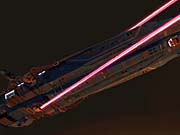
DI: Homeworld 2's epic story draws the player into the conflict on the side of the hiigarans. We're saving the other side of this story for an expansion pack. The persistent-fleet concept is still used, but we've modified the implementation so you won't have to go back a few missions if you're unsuccessful in preserving enough ships from mission to mission. We found it was important to the gameplay since it created a sense of ownership and familiarity in the single-player experience.
JM: The use of persistent fleets is one area where Homeworld and Homeworld 2 stand out from other RTS games. Instead of having to rebuild your fleet at the start of every mission, units are carried over from mission to mission. We've also tweaked the system to scale better in terms of difficulty.
GS: What sort of resource model do you have planned for the game? Is the mothership still at the core of unit production and the economy?
DI: The mothership remains the core of unit production and the economy, but we have included alternatives to ship production. The hiigarans' technology has advanced significantly over the years, and they're now able to construct capital ships and strike craft in other ships. These are the carriers and a new unit, the shipyard. That's all I can say about that for now.
JM: The mothership is central but certainly not the only unit that will affect a player's production and economy. Some ships will be better at managing resources operations, while others will have better production capabilities.
GS: What sorts of units are in the game? Is there still the basic balance between fighters, corvettes, and capital ships?
DI: The units are divided up primarily along the established lines: strike craft, corvettes, frigates, capital ships, and the mothership. So the balance is very familiar. However, the implementation, tactics, and gameplay are considerably deeper.
JM: We're also going to great lengths to make sure all units have a purpose. It is not a matter of rushing to the battle cruiser in order to win. Bigger is not always better. A battle cruiser, decked out with turrets and ion beams, is a force to be reckoned with, but without fighter and corvette support, it has its weaknesses. Combined tactics and fleets feature predominantly in Homeworld 2's balance model.
GS: Is the research system the same as before? Is there a system for upgrading individual units?
DI: Individual units can upgrade, but the upgrade generally applies to an entire class of unit. There are some exceptions, but that's the general rule.

JM: The introduction of subsystems adds new and interesting tactical depth to Homeworld 2's research system. Players will be able to build key modules to customize their larger ships. Some sample subsystems include fighter production bays, fire control towers, and cloaking generators. Of course, players can target these subsystems, allowing them to perform surgical strikes on their enemy's fleet. If your opponent keeps building assault corvettes, take out his or her corvette facilities to give your bombers free rein.
Bigger Fireworks
GS: What are the most distinctive units in the game?
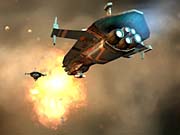
DI: This was a unique challenge. The most distinctive units in the game are the vaygr. Consequently, the vaygr destroyer is one of the most distinctive units, with its offset hull used for plasma beam generators. The art director for Homeworld 2, Rob Cunningham, designed a fleet that features a functionally different style--one that is predominantly vertical. Contrary in style to the hiigarans' flat fleet-building approach, this design makes the vaygr stand out as the antagonists. This allows the player to easily identify enemy ships at a distance. Of course, we've continued to add details like color accent to the key weapons or special abilities of the ship so their function is easily recognized.
JM: Definitely the larger capital ships stand out. Among my favorite is the vaygr carrier, but also the hiigaran destroyer--though if you ask around the office, the hiigaran battle cruiser always comes up as a favorite. We've added small touches like vertical missile launchers that help further distinguish these ships.
However, the most distinctive units in the game are some of the unique single-player ships--but these will remain a secret for now.
GS: One of the challenges in designing maps for an RTS set in space is simply how wide open the maps tend to be. Is there anything new in the way you approached the design of the sequel's maps?
DI: One of the major improvements Homeworld 2 makes on Homeworld is the use of nebulas, dust clouds, megaliths (hulks in space), asteroids, and debris. While these provide visual reference, they also add strategic importance and are integral to story progression and the suspension of disbelief. The use of these types of elements in Homeworld was very limited compared with what we've done in Homeworld 2. I can't wait for everyone to see them in the game!
JM: We wanted to create a "living battlefield" for Homeworld 2. This is decidedly difficult in space, but what we have certainly goes a long way toward adding environmental gameplay to our maps. Dust clouds obscure sensors, nebulae can cause ships to malfunction, and megaliths can support subsystems. In short, space is not empty in Homeworld 2, but, rather, is filled with possibilities.
GS: Homeworld's impressive graphics mean the expectations are pretty high for the new game. Tell us what we should expect from the game's visuals. Has the newer hardware enabled you to take a big step forward?
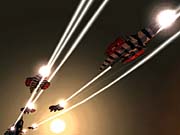
DI: Definitely! We're really excited about what we can do with the new hardware from both Nvidia and ATI. They've made some real strides that will help us make a fantastic-looking game. One of the new features that we're using are pixel shaders, which allow us to have textures that emit light on a per-pixel basis. They bring realism to the hangars, the bridges of ships, and the engines. Also, specular maps--a part of the pixel shaders--allow us apply damage to shiny surfaces. Players can see the damage to their ships, as well as differentiate completely damaged from roughed-up areas and undamaged areas. You'll also be amazed at the dynamic lighting. When flying near a fleet of ships, you'll see that they actually cast light on each other. This adds tremendous depth to the realism.
On the core technology side, we're using vertex programs that transfer some of the vertex calculation load from the CPU to the video card so the CPU is free to do more-advanced physics, flight dynamics, and artificial intelligence. As a side note, we're also using normal maps to implement per-pixel lighting with bump mapping--we have some exiting places to show you that are inside asteroids.
The Voyage Ahead
GS: Simply because it let players move units in all three dimensions, Homeworld's interface was pretty intimidating, even for experienced RTS players. Are you making changes to the interface this time around?
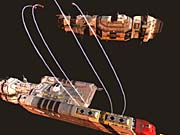
DI: We've refined it so the user can use an onscreen interface to manage the construction of new ships, as well as manage the fleet. This eliminates the need for the player to constantly switch screens, back and forth from the game environment to the build manager. We've also included an advanced tactical overlay on the screen that can be toggled so the fans can select any degree of the user interface that they choose--all, some, or none. Of course, we've employed the standard RTS features like a taskbar, a fleet manager, and hotkey grouping. This was one of the weaknesses of Homeworld, so we're really focusing on improving its implementation in Homeworld 2.
JM: We've also made some improvements to the camera, making it easier to manipulate. The introduction of camera panning, a staple in RTS games, will help ease new players into Homeworld 2's 3D world. Panning also makes it easier to move units, since the player can pan the camera to the desired destination, something that was not possible using Homeworld's camera. Right-click context-sensitive commands also make simple tasks like moving, attacking, and harvesting easier to execute.
GS: Tell us about your multiplayer plans for Homeworld 2.
DI: We've included a few multiplayer modes and maps, allowing six players to play at once. I think the biggest improvement is that there will be additional fan-created content available shortly after the game ships to retail stores.
JM: The addition of subsystems, dust clouds, and other environmental features will enhance the competitiveness of multiplayer matches. We're currently exploring a number of different game modes using our propriety scripting tool, SCAR, which allows us to try some new and interesting twists on the standard multiplayer modes. I guess the short answer is "Wait and see."
GS: Are there plans for a public beta?
DI: Yes, there are plans for a number of tests. To sign up and see if you qualify for one of them, visit www.homeworld2.com. We're also planning on having beta discs available at retail as we get closer to launch. We'll be making more announcements about it later this spring.
GS: Do you plan to release editing tools?
DI: Some of our tools will be released, once they are properly documented and improved. Others require a license for Maya 3.0. We'll have more details on exactly what tools will be available as we get closer to the summer. The Relic Developer Network will continue to support our products with release versions of the tools and documentation.
GS: How long have you been working on the game? How far along is it?
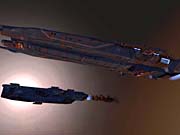
DI: The game has gone through several stages. We've been working on it in one form or another since early 2000. Early on, we invested in R&D. After that, we focused on building an engine. We're finalizing the tools and building the game. Our entire focus is on making a great game for release in the third quarter of 2003.
GS: Is there anything else you'd like to say about the game?
DI: A quote from Vegetius' Rei Militari that epitomizes the back story of Homeworld 2: "Qui desiderat pacem præparet bellum." He who would desire peace should be prepared for war.
If you can get this quote, you'll be way ahead of the game.
Got a news tip or want to contact us directly? Email news@gamespot.com
Join the conversation